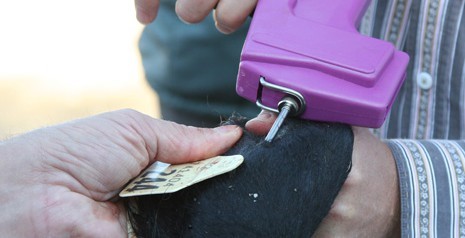Implants – Getting the Most out of Them
Posted: June 28, 2018 | Written By: Heidi Doering-Resch, M.S.

Which implant should I use? How many days does it last? What happens if I don’t implant at the proper time? What hormone levels should I be using? These are all viable questions if you want to understand how to get the biggest return on investment (ROI) out of your implant program. In the beginning of June, Form-A-Feed, Inc and Zoetis Animal Health co-sponsored an implant clinic down in Luverne, MN. Attendees were able to witness and understand how the selection of an implant can be an important tool in ensuring your cattle can maximize their potential gains and how to go about ensuring technique was fine-tuned.
An implant can provide as big of a return as 10:1, but it can also, when done incorrectly, reduce your profits. A crushed or abscessed implant not only means you are out the cost of the implant, but also about 100 lbs. of live weight in a steer. So aside from proper placement and selection, what else should one pay attention to when implanting? From a nutrition stand point, implants are only as good as the groceries that the animal is consuming.
Today’s implant technologies provide many options for producers to implant cattle in a way that is best suited for their management styles and selling goals. Putting implant management aside, if you implant cattle prior to having their caloric intake in check with their now enhanced metabolic growth, you will reduce cattle grade and most likely get a call from your cattle buyer. If you can effectively implant cattle matching implant hormone levels and maximizing cattle intakes, the level of both performance and grade will be maximized, as well as your return.
Spending time on what it takes to maximize caloric intake takes a nutritional perspective relating to stable feeds and accurate feed energy tests. Stable feeds do not contain additional molds or yeasts that may reduce the amount of feed intake due to taste. Or reduce energy and protein density of the feedstuffs that the animal is consuming due to heating and molds. Certain molds can contain hormone levels that can add to a newly releasing hormone load from the implant, adding to the animal’s absorbable hormone level. The producer will see bull type behavior, heifers which tend to bag when not bred, additional riding even if on MGA (Melengestrol acetate) and aggressive social behavior. We understand that unneeded social behavior in the feedlot pen can be detrimental to performance as well as health of the animal due to injury.
Nutritionists test fermented-type feedstuffs and corn products to ensure proper energy density as well as understand if there will be a mold or mycotoxin type interaction. Do you ever wonder why your nutritionist will test your fermented feedstuffs twice within a feeding year; and normally coincide with going into the terminal implant? It’s so they can make any needed ration adjustments prior to when cattle are predisposed to be the least efficient, while also helping maximize that terminal implants job through maximizing caloric intake. Money well spent in my book.
Implant technique and management are crucial in setting up the implant to give the biggest ROI. Nutritionally, the implant will not meet it’s potential and neither will the steer, if the calories going in are not maximized as well. If you have any further questions on how to manage your feedstuffs please be sure to contact your local Form-A-Feed representative.